Events of Monday 5th May 2014
At 7.00 a.m. I said goodbye to my new friends Marco and Carlotta who left the Princess Resort, returning to Sittwe on one of the Resort’s boats.
Mrauk U market
The driver and guide collected me in the Jeep at 8.00 a.m. and we had a further look round the market. The ‘Covered Market’ was also open since it was a weekday – it had been closed the previous day. A new batch of Chinese-made pedal bicycles was being unloaded from a pick-up truck. An improbably large number of bicycles had somehow been carried and men were trying to extricate the load one machine at a time. We looked at water pots on sale. In this area, they’re usually metal and I’d assumed they were spun aluminium, but I was told they were zinc, to keep the weight down, and imported from Bangladesh. There was a wide range of solar panels, both Chinese and Indian, pharmacies with a wide range of drugs and herbal remedies and a barber’s shop.
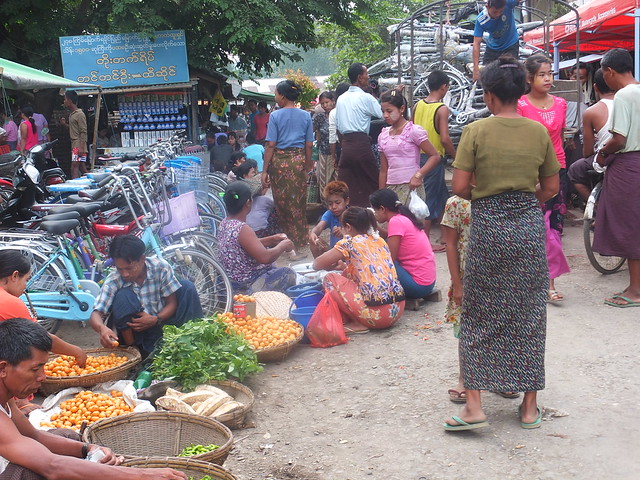 Mrauk U market. In the background, men unload a consignment of new Chinese bicycles from a pick-up truck.
Mrauk U market. In the background, men unload a consignment of new Chinese bicycles from a pick-up truck.
Village life
The Jeep then took us to a small village not far away and we walked round. The villagers were curious but not unfriendly. The village had its own small market comprising half a dozen stalls. These ‘convenience stores’ avoided a walk to the town.
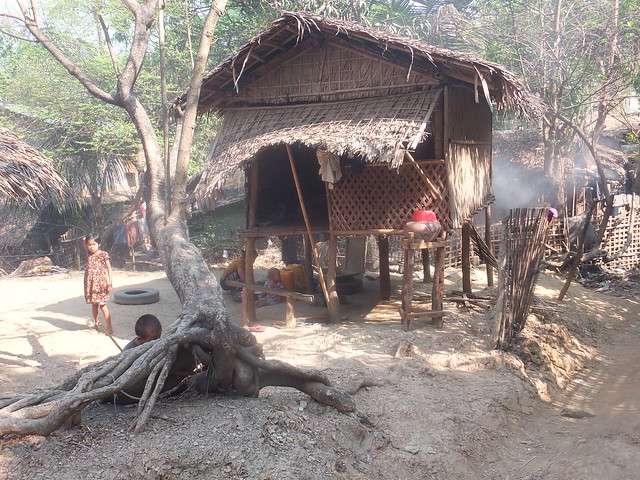 A modest family home.
A modest family home.
At the edge of the village, next to a small monastery, men were carrying out repairs to the village rainwater pond. The banks of the pond were being built up manually with lumps of clay soil which, when damp, would form a waterproof lining. This pond was completely dry. As ponds dry out, the villagers have to rely on other sources further away. The start of the rainy season is always anxiously awaited to replenish their supplies of water. A short walk took us to a muddy patch where two large pigs were happily relaxing, covered in mud. Nearby, there was a smaller rainwater pond which still contained some water.
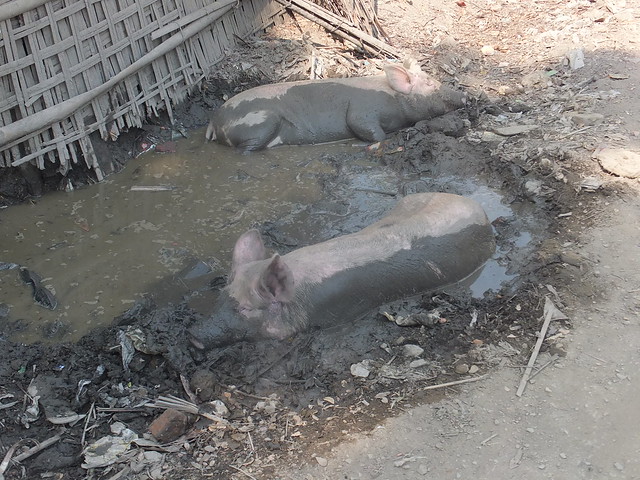 With temperatures around 42 degrees Celsius, these pigs were happy to relax in mud.
With temperatures around 42 degrees Celsius, these pigs were happy to relax in mud.
In the days of its former glory, the area was home to numerous libraries containing scriptures. The local head monk allowed us to visit one such library, in ruined condition but with some restoration work carried out.
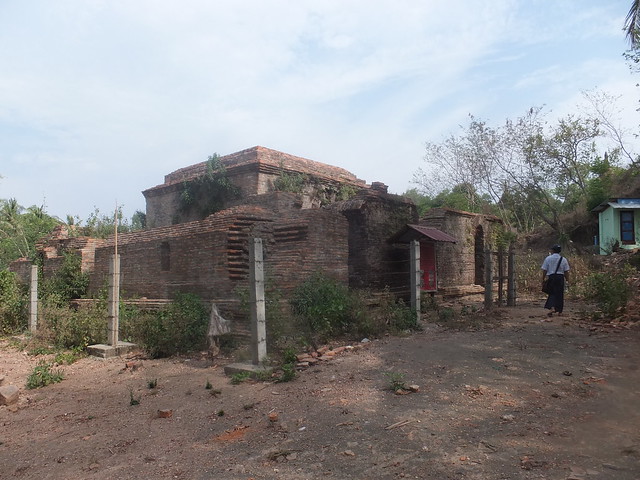 We visited this ruined library.
We visited this ruined library.
Sakya Manaung Pagoda
We then rejoined the Jeep and drove to the Sakya Manaung Pagoda, built by King Thiri Thudhamma Raza in 1629 to commemorate the reigns of the Sakya clan. We approached from the western gate, which is protected by two large stone ogres. The main pagoda is built of stone, elaborately carved, 114 feet in height and is surrounded by twelve smaller pagodas. A stone wall encloses the compound.
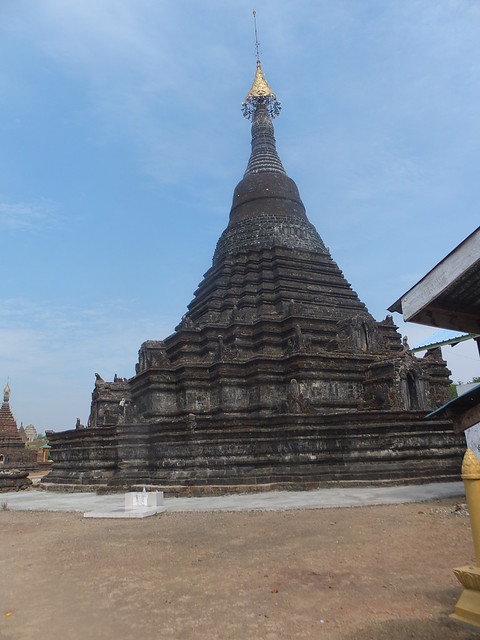
The main pagoda at Sakya-Manaung.
Ratana Manaung Pagoda
Another drive to the north took us to the Ratana Manaung Pagoda. Founded by King Sanda Thudham-maraza and Queen Ratana Piya Dewi in 1658, it is dedicated to the 'Three Buddhist Gems' (the Buddha, the Dhamma and the Sangha). The pagoda is stone, eight-sided and 180 feet in height.
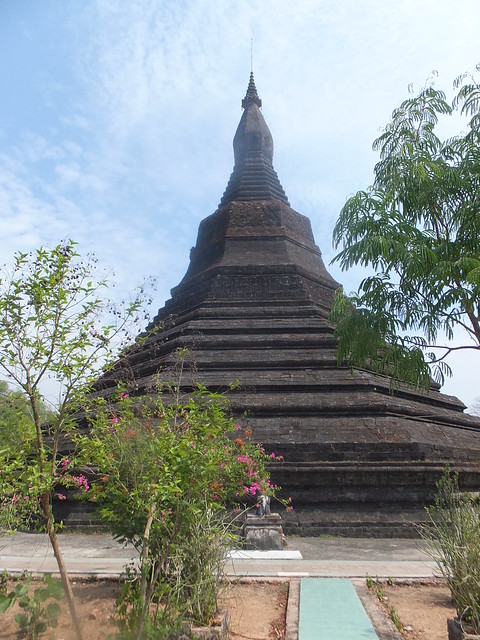
Ratana Manaung Pagoda
A stone wall encloses the compound - in the north-west corner is a stone-built 'cave', 54 feet long, 13 feet wide and 10 feet in height which originally served as the King's Sabbatical Chamber. This building is called the Guphu ('White Cave') and now houses a number of painted Buddha images.
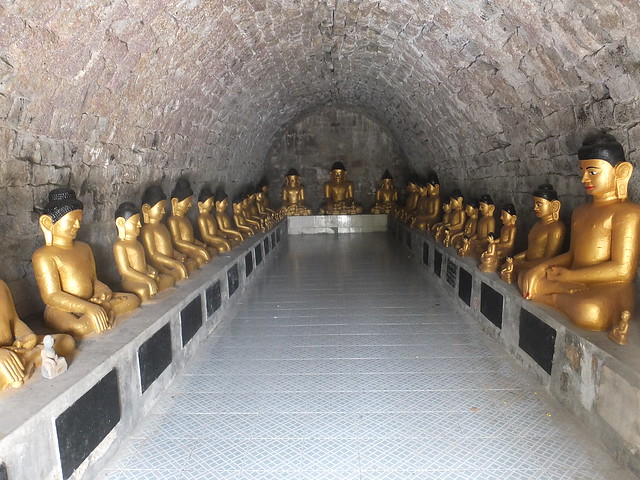 Inside the 'White Cave'.
Inside the 'White Cave'.
There is a modern monastery adjacent to the pagoda compound. Another short drive took us to Andaw-thein Temple and the adjacent Ratanabon Pagoda.
Andaw-thein Temple
This temple was originally built by King Mong Razagri in 1596 to house the "molar tooth relic" brought from Sri Lanka. The relic was moved to the Sanda Muni Monastery and the present octagonal Andaw-thein pagoda surrounded by eight smaller octagonal pagodas is due to King Mong Saw Hla.
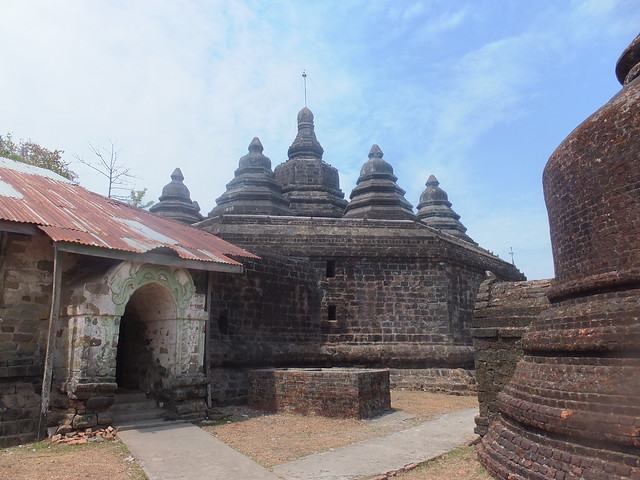 Andaw-thein Temple
Andaw-thein Temple
Inner, vaulted passages lined with Buddha images lead to a central chamber.

Andaw-thein Temple>
Ratanabon Pagoda
This pagoda was donated by King Khamoung in 1612. I walked among the numerous brick-built satellite pagodas. We were now close to the fortress-like Htuk Kant Thein Temple we’d only seen from the outside the previous day.
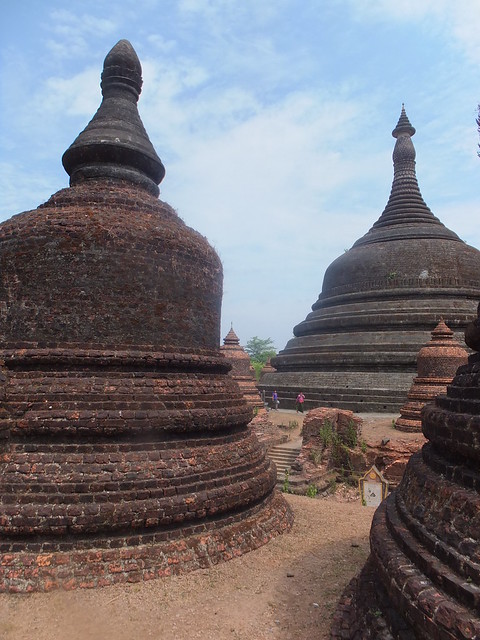 The main pagoda in the background dwarfs the visitors walking by. The main pagoda is surrounded by a number of smaller, brick-built pagodas.
The main pagoda in the background dwarfs the visitors walking by. The main pagoda is surrounded by a number of smaller, brick-built pagodas.
Htuk Kant Thein Temple
This interesting temple dates from 1571. It was donated by King Mong Phalaung and Queen Shun Latt. It has a rectangular plan measuring 137 feet (east-west) and 110 feet (north-south). Once inside, it took us some time to spiral twice clockwise around its broad internal passage lined with 146 stone Buddha images set in niches.
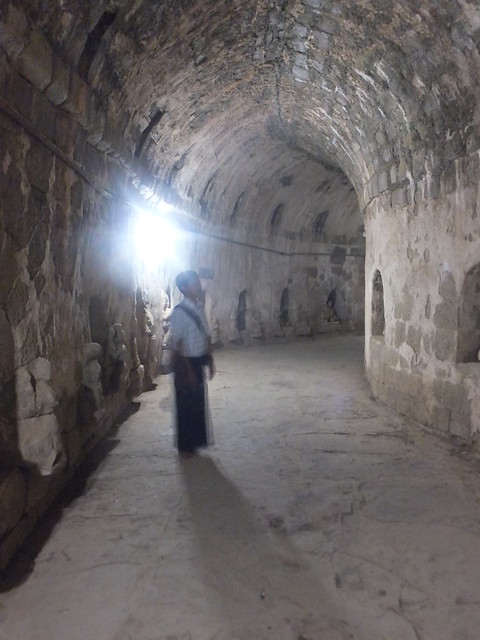 The spiral passage makes two complete circuits of the building.
The spiral passage makes two complete circuits of the building.
We then entered a chamber with stone steps leading up to an inner temple.
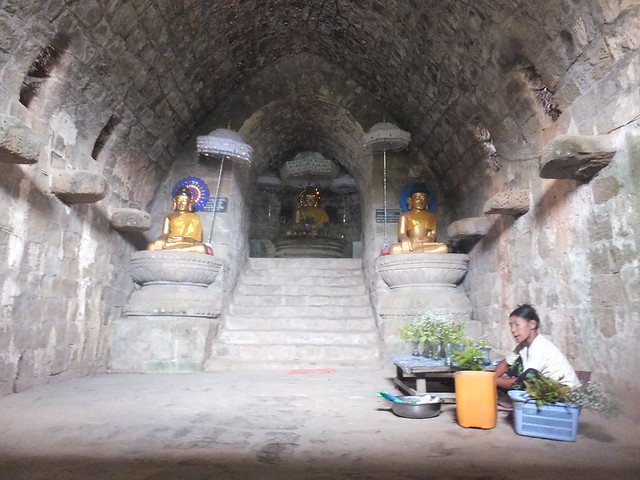 The inner temple at Htuk Kant Thein.
The inner temple at Htuk Kant Thein.
After this interesting tour, I was returned to my hotel for a rest before our final exploration. I was now the only guest in the hotel, and a gang of about 30 builders had started banging and hammering in the main building housing the restaurant. A very cold Coca Cola with lots of ice and a plain salad in the restaurant revived me. The hotel staff were very apologetic about the 'noises off' but I tried to reassure them that it was not a problem.
The horizon darkened and a ferocious wind started up. Quickly finishing my lunch, I trotted through the gardens to my cottage as it was starting to rain. After a rest, I emerged to find the weather significantly improved.
Around Mrauk U
Late afternoon, I was again picked up by my guide, driver and 'Jeep' for the last excursion at Mrauk U. We drove to a beautiful complex of lakes on the south side of Mrauk U which not only provide a reliable source of drinking water but are popular for recreation with swimming and canoeing possible. We walked for some time around the lakes, allowing me to study the different methods of water collection in use and ponder the life style. I'd spotted flat 'washing stones' on the shore of the lake and, after a while, two ladies arrived to do a bit of washing. A group of young people took to the water for a swim. To increase the possibilities for swimming games, one or two hired inflated lorry tyres from a small business on the shore which also rented boats. The water was quite shallow, so it was quite a safe location.
 Lat-say-kan Lake, Mrauk U.
Lat-say-kan Lake, Mrauk U.
Looking inland, I watched a group of boys playing ball games in a field. At the side of the path we were taking, we passed an elderly woman who had made a small wood fire on the ground and she was happily cooking a piece of beef.
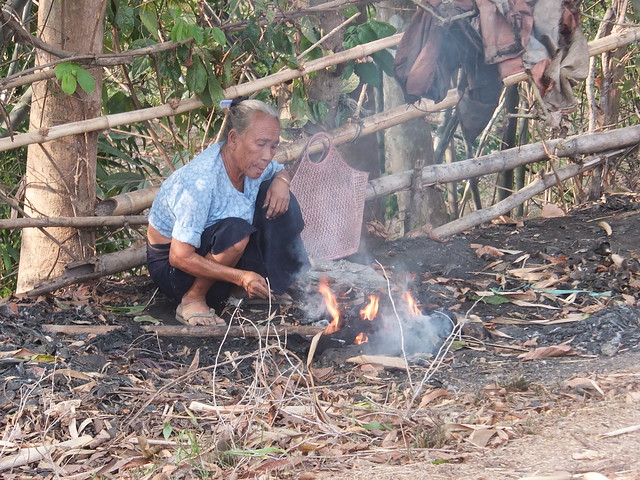 An elderly woman cooking at the side of the path.
An elderly woman cooking at the side of the path.
We continued to a small village. A 'thatcher' was trying to complete roof repairs to one of the houses using sections of palm leaves before it became dark. In Bagan, this method of roofing lasts around three years - I didn't find out whether Mrauk U is similar. Our 'Jeep' has gone ahead to the village and was waiting for us.
Hilltop Pagoda
Near the centre of Mrauk U, we made our last pagoda visit. A steep path led uphill to a modern monastery complex set on a plateau. We then faced quite a stiff climb up steps to the pagoda set on the hilltop. A European gentleman was at the top, practicing meditation and accompanied by his own guide. Other than Marco and Carlotta, he was the first European I'd seen since leaving Sittwe.
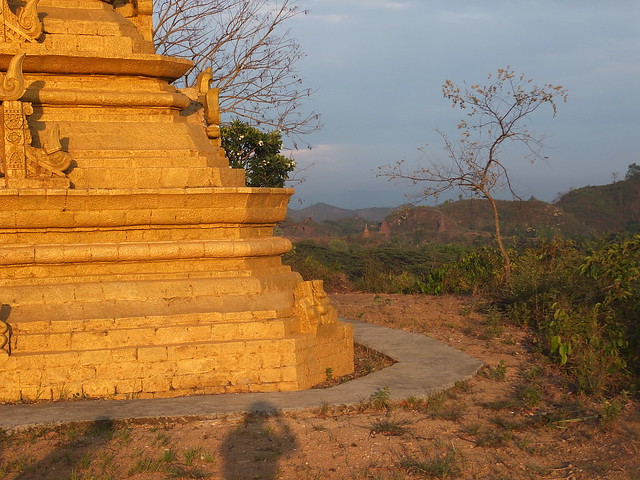 View from the Hilltop pagoda, with a group pf pagodas visible in the distance.
View from the Hilltop pagoda, with a group pf pagodas visible in the distance.
Then it was back to the hotel, tired but happy. The following morning, I was to board a hotel boat at 7.00 a.m. for my own journey back to Sittwe. I readily agreed to take breakfast on the boat.
My Pictures
Mrauk U Princess Resort.
Mrauk U and its Market.
Around Mrauk U.
Mrauk U: Sakya Manaung Temple.
Mrauk U: Ratana Manaung Zedidaw.
Mrauk U: Andaw-thein Temple.
Mrauk U: Ratanabon Pagoda.
Mrauk U: Htuk Kant Thein Temple.
Mrauk U: Hilltop Pagoda.
More
Next Post describing this trip.
[Revised 2-Jun-2014, 4-Jun-2014]
